Home based exercise therapy is a targeted approach, closely linked to physiotherapy, that aims to improve mobility, strength, balance, and overall function without leaving your living room. Unlike generic workouts, it is designed by healthcare professionals often physiotherapists to meet your specific medical needs, whether you are recovering from injury, managing chronic pain, or working to prevent future problems. Sessions may include gentle stretches, core‑strengthening moves, balance drills, and flexibility exercises, all adapted to your comfort level. With minimal equipment like resistance bands, a yoga mat, or even a sturdy chair, you can boost blood flow, ease stiffness, and build resilience right at home..
Safety is key: progress gradually, watch for warning signs, and seek medical guidance before starting. For many Canadians, it’s not just convenient.it’s a lifeline that restores independence, reduces healthcare visits, and fits seamlessly into daily life. Home exercise therapy proves that the road to recovery can start in your own living room.
What you will read…
What Is Exercise Therapy?
Exercise therapy is a medically designed program that uses targeted physical movements to restore, maintain, or improve health and function. Unlike general fitness routines, it is prescribed by healthcare professionals and tailored to each patient’s needs, whether they are recovering from injury, managing chronic pain, or preventing future mobility issues. Common elements include stretching routines, strengthening exercises, balance drills, and flexibility training all performed at a safe, progressive pace. Using minimal equipment such as resistance bands or stability balls, exercise therapy can be delivered in clinics, rehabilitation centres, or even at home. The core advantage lies in its evidence‑based approach, ensuring every movement supports healing without overloading the body. For many, it is a cost‑effective, empowering path to better physical health and long‑term independence.
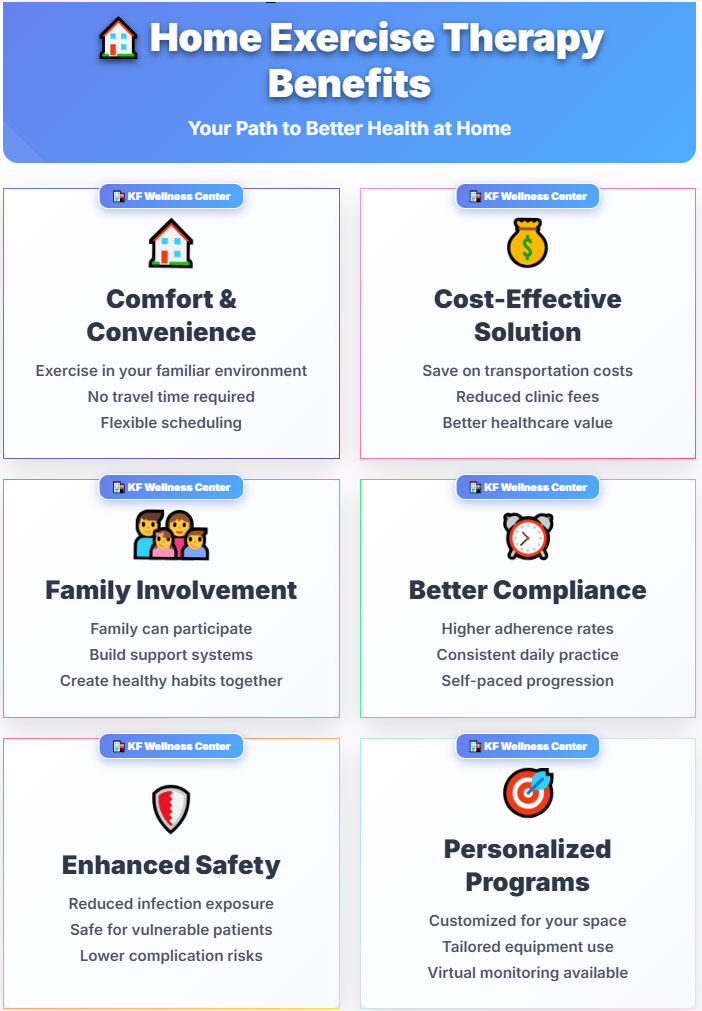
comparing exercise therapy with general exercise
| Aspect | Exercise Therapy | General Exercise |
|---|---|---|
| Goal | Restore health, treat injuries, improve function | Improve fitness, strength, and endurance |
| Design | Tailored by healthcare professionals | Self‑planned or guided by fitness trainers |
| Target Audience | Patients, people with medical conditions or recovery needs | Healthy individuals without active injury |
| Focus | Rehabilitation, pain reduction, mobility improvement | Performance, aesthetics, overall conditioning |
| Intensity | Controlled and gradually increased | Often moderate to high, depending on fitness goals |
| Risk Level | Low, with medical supervision | Higher if not performed with proper form |
| Setting | Clinic, home, or rehab centre | Gym, sports field, home |
| Equipment | Minimal, therapeutic tools | Wide range, from bodyweight to heavy weights |
The Role of Exercise Therapy in Improving Body Function
Exercise therapy, often incorporating principles of kinesiotherapy, plays a critical role in restoring optimal body function by targeting muscles, joints, and the nervous system in a coordinated way. It strengthens the body’s support structures, improves range of motion, and enhances balance, making daily activities safer and easier. Through repetitive, controlled movements, it retrains the brain‑muscle connection, improving coordination and posture. Scientific studies in Canada show that structured exercise therapy reduces pain, speeds recovery after surgery or injury, and lowers the risk of future complications. Delivered consistently and with proper supervision, it bridges the gap between clinical treatment and independent living.
Categories of Home Based Exercise Therapy
Home based exercise therapy covers a wide range of targeted movements designed to restore, protect, and enhance physical function. Canadian physiotherapists typically group these exercises into four main categories: mobility and range of motion drills for joint health; strengthening exercises to stabilise muscles and prevent reinjury; balance training to improve coordination and reduce fall risk; and flexibility work to maintain muscle length and promote comfortable movement. Each category addresses specific rehabilitation goals and can be adapted to suit different recovery stages. This structured approach ensures that exercises not only meet short‑term needs, like pain relief, but also support long‑term independence. By combining all four categories into a consistent routine, patients can rebuild strength, regain confidence, and safely return to daily activities without relying solely on clinic‑based treatment.
Massage at home offers the comfort and privacy of receiving professional‑quality care without travelling to a clinic. Designed to reduce muscle tension, improve circulation, and promote relaxation, home sessions can be adjusted to personal needs from stress relief to recovery after injury. Canadian massage therapists often combine gentle techniques with targeted pressure to ease stiffness and improve range of motion. With minimal equipment, such as a portable massage table, clean towels, and soothing oils, clients can enjoy the full benefits of therapy. This convenient approach saves time, encourages consistency, and supports both physical wellness and mental well‑being year‑round.
Mobility and Range of Motion Exercises
Mobility and range of motion exercises are the foundation of home exercise therapy, designed to keep joints lubricated and muscles active without adding excessive strain. These movements encourage circulation, reduce stiffness, and maintain the body’s natural flexibility. In Canada, physiotherapists often include gentle, repetitive motions that can be done daily without special equipment. These routines focus on key joints such as the knees, hips, shoulders, and spine. The goal is to prevent joint capsule tightness and muscle shortening, common after injury or prolonged inactivity. For people recovering from surgery or managing chronic conditions, mobility drills are often performed in short sessions, multiple times a day. When done properly, they restore confidence in movement by reducing pain and improving control, making everyday activities like walking, bending, and reaching safer and easier.
Knee Flexion and Extension
The knee flexion and extension exercise is a simple yet highly effective way to keep your knee joints healthy and mobile at home. While seated on a sturdy chair, gently straighten one leg until it is parallel to the floor, then slowly bend it back to the starting position. Repeat in a controlled rhythm, focusing on smooth, pain‑free movement. This exercise strengthens the quadriceps, improves joint nutrition through increased blood flow, and maintains full functional mobility. It is often prescribed for post‑surgery rehabilitation or in early arthritis care to minimise stiffness. No special gear is required, making it ideal for daily practice. For best results, keep your back supported and avoid locking the knee. Over time, this movement can help restore independence in walking, climbing stairs, and performing daily tasks without discomfort or instability.
Hamstring Stretch
The hamstring stretch is an essential exercise in home‑based therapy programs for improving flexibility in the back of the thigh and supporting lower back health. Sit on the edge of a sturdy chair, extend one leg forward with the heel on the floor, and keep the other foot planted. Keeping your back straight, lean slightly forward at the hips until you feel a gentle stretch behind your thigh. Hold for 15 to 30 seconds and repeat on the other side. This stretch helps ease tension that can pull on the pelvis and spine, reducing the risk of back pain. Regular practice improves walking stride length, athletic performance, and posture. It requires no fancy equipment and is safe for most people, making it one of the most accessible and effective stretches for home therapy routines.
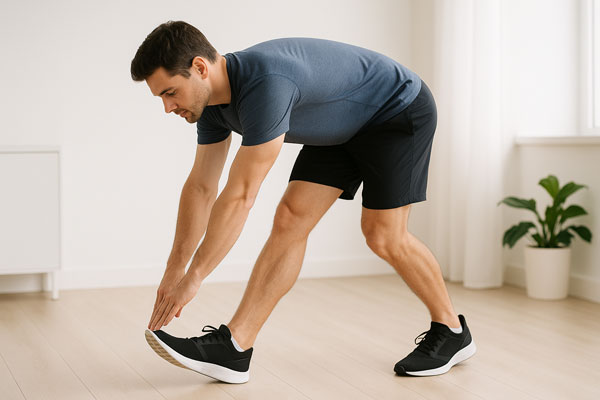
Strengthening Exercises
Strengthening exercises in home‑based exercise therapy are specifically designed to build muscle endurance and stability without risking injury. They focus on core muscles, lower and upper limbs, and the supportive structures around joints. By targeting weak areas, they help offload pressure from damaged tissues, reduce pain, and improve posture. In Canada, physiotherapists often integrate body weight moves like bridges, planks, and wall‑sits into rehabilitation plans. These exercises not only rebuild lost strength after surgery or injury but also act as a preventive measure against future musculoskeletal problems. They can be adjusted in difficulty by modifying speed, range, or resistance, making them suitable for people at different recovery stages. When performed regularly with correct form, strengthening exercises establish a solid physical foundation for daily life and support long‑term joint health.
Glute Bridge
The glute bridge is a powerful yet accessible move that strengthens the glutes, hamstrings, and lower back while promoting hip stability. To perform, lie on your back with knees bent and feet flat on the floor, hip‑width apart. Press your heels into the ground, engage your core, and lift your hips until your body forms a straight line from shoulders to knees. Pause for two seconds, then return slowly. This exercise relieves pressure on the lower spine, improves pelvic alignment, and enhances walking and climbing ability. In rehabilitation, it is used to counteract weakness from prolonged sitting or injury recovery. Recommended by Canadian physiotherapists, the glute bridge requires no special equipment, is safe for most conditions, and can be easily modified in intensity, making it a staple in home‑based strength programs.
Forearm Plank
The forearm plank is one of the most effective core‑strengthening exercises in home‑based therapy, targeting the abdominals, back, and shoulder stabilisers. Begin by lying face‑down, then lift your body onto your forearms and toes, keeping elbows under shoulders. Engage your core, maintain a straight line from head to heels, and avoid letting hips sag or rise. Hold for 10–30 seconds, gradually increasing time as your strength improves. This exercise builds stability, reduces lower back strain, and supports better posture during daily activities. Physiotherapists recommend the plank for its low‑impact nature and suitability for people recovering from injury. By training the deep core muscles, it helps protect the spine and enhances balance. No equipment is needed, and it can be done anywhere, making it an ideal addition to any home‑based program.
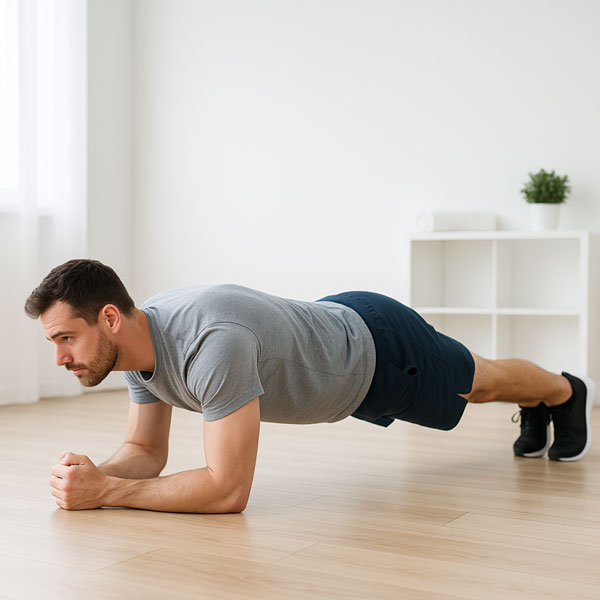
Balance Exercises
Balance exercises are key to preventing falls, enhancing coordination, and building confidence in movement — especially in older adults or those recovering from injury. In home‑based exercise therapy, these movements train the body to stabilise joints under changing positions. Exercises often involve standing on one leg, shifting weight, or using unstable surfaces like a cushion or balance board. Physiotherapists in Canada see balance work as essential for reducing ankle sprains, hip fractures, and overall mobility decline. Besides safety benefits, balance training improves athletic performance by fine‑tuning reaction time and joint control. Performed regularly, these exercises protect independence in daily life and make walking, turning, and bending safer. They are gentle on the body, require little space, and can easily be integrated into a home therapy program for all fitness levels.
Single Leg Stand with Support
The single leg stand with support is a simple but effective balance exercise for home therapy. Stand beside a sturdy surface like a wall or counter for stability. Lift one foot a few centimetres off the ground, keeping your gaze forward and spine straight. Hold for 10–20 seconds before switching legs. This exercise trains the small stabilising muscles in the ankles, knees, and hips, improving coordination and reducing the risk of falls. Physiotherapists recommend it for post‑surgery rehabilitation, injury prevention, and early‑stage balance training. Using light hand support ensures safety without completely offloading the challenge, making it suitable for beginners. Over time, reducing hand contact increases difficulty. The single leg stand builds confidence, supports joint health, and can be practised almost anywhere without the need for equipment.
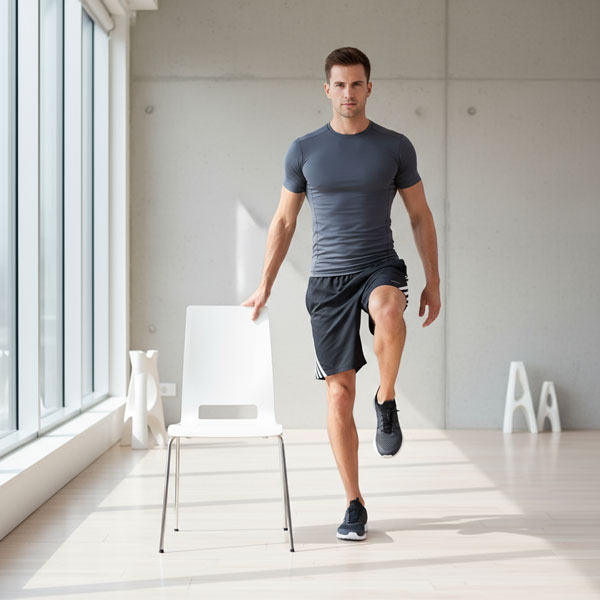
Flexibility Exercises
Flexibility exercises in home‑based therapy help maintain or restore the length of muscles and connective tissues, allowing joints to move freely and without discomfort. They are essential for reducing muscle stiffness, preventing contractures, and supporting healthy posture. Canadian physiotherapists often integrate flexibility work with strength and balance training for a complete rehabilitation plan. These movements are slow, controlled, and held long enough to encourage gentle tissue elongation. Performed regularly, they improve functional reach and make daily activities like bending, lifting, or dressing easier. Flexibility drills also enhance blood flow, contributing to quicker recovery from strain or surgery. The focus is always on pain‑free motion, ensuring tissues are protected while gains are made. The two classic examples in home therapy are the hip flexor stretch and the cobra pose.
Hip Flexor Stretch
The hip flexor stretch is a targeted flexibility move designed to release tightness in the muscles at the front of the hip, often caused by prolonged sitting. Kneel on one knee with the other foot planted in front, forming a 90‑degree angle in both legs. Keeping your torso upright, gently push hips forward until you feel a stretch across the front of the hip and thigh. Hold for 20–30 seconds and switch sides. This exercise improves stride length, reduces lower back strain, and supports pelvic mobility. In home‑based rehabilitation, it is frequently used for postural correction and recovery from hip or knee injuries. Recommended by physiotherapists, it requires no equipment, takes minimal time, and delivers noticeable relief when practised consistently, making it perfect for daily therapy routines.
Cobra Pose
The cobra pose is a gentle back extension that strengthens the spine while improving flexibility in the chest and abdominal muscles. Lie face‑down with hands under the shoulders, elbows close to your body. Press through your palms to lift your chest off the floor, keeping hips grounded and shoulders relaxed. Hold for 10–20 seconds, breathing steadily. This stretch opens the front of the torso, counteracts the effects of prolonged sitting, and supports spinal alignment. In Canadian home‑based therapy, it is often recommended for people with mild lower back stiffness or poor posture, provided it is pain‑free. The cobra pose also promotes spinal mobility and can be an early step before advancing to more demanding back exercises. It is accessible, equipment‑free, and easily integrated into a balanced daily stretching plan
Safety Conditions and Precautions Before Starting
- Medical Clearance: Get approval from a qualified healthcare professional, especially if you have chronic conditions or recent injuries.
- Pain‑Free Range: Move only within a pain‑free range of motion; stop immediately if you feel sharp or unusual pain.
- Proper Space: Ensure the exercise area is clear of obstacles to prevent trips or falls.
- Safe Surface: Use a non‑slip mat or stable flooring to reduce injury risk.
- Warm Up: Perform 5–10 minutes of gentle activity to prepare muscles and joints.
- Proper Footwear: Wear supportive shoes suited to the exercise type.
- Hydration: Keep water nearby to maintain hydration during activity.
- Listen to Your Body: Adjust intensity according to your comfort and fitness level.
- Progress Gradually: Increase difficulty slowly to avoid overuse injuries.
- Assistive Support: Use a chair, wall, or railing when practising balance or stability exercises.
Exercise Therapy for Specific Body Areas
Exercise therapy for specific body areas focuses on targeted movements that address pain, weakness, or reduced mobility in a defined region. Canadian physiotherapists design these programs to protect vulnerable tissues while restoring functional strength. Each area, from the spine to the shoulders, requires a unique approach combining strength, flexibility, and stability. For example, the lower back benefits from core activation, while knees rely on controlled weight‑bearing drills. Consistent practice not only improves recovery but also prevents recurrence of injury. A balanced, area‑specific routine can be done at home, improving daily movement confidence and long‑term musculoskeletal health.
Lower Back and Spine
The lower back and spine carry the body’s weight and demand careful, targeted rehabilitation after injury. Home based exercise therapy for this area emphasises mobility, core strength, and posture correction. Canadian physiotherapists often choose gentle flexion and extension drills, reducing pressure on discs while boosting blood flow to muscles. The Williams techniques and the cat cow stretch are two proven methods to maintain spinal alignment and decrease discomfort. A gradual progression in intensity prevents flare ups and supports safe recovery. By reinforcing surrounding muscles, these exercises ensure the spine remains stable, allowing better function during bending, lifting, and daily tasks.
Williams Techniques
Williams techniques are classic flexion‑based exercises for relieving lumbar spine stress. Movements such as single knee to chest, partial sit ups, and seated forward bends open the spaces between vertebrae, reducing nerve compression. Canadian physiotherapists recommend them for patients with specific disc issues, always ensuring slow, controlled execution. These drills also stretch hamstrings and strengthen core muscles, supporting posture and stability. Performing them regularly at home helps reduce stiffness, enhance flexibility, and maintain a healthy range of motion. Simple to learn and equipment‑free, the Williams techniques are a safe, accessible option for improving lower back comfort and protecting spinal structures.
Cat Cow
The cat cow exercise is a gentle spinal mobility drill widely used in physiotherapy programs. Starting on hands and knees, you alternate between arching your back upward (cat) and lowering your belly while lifting your head (cow). This rhythmic motion improves flexibility, increases circulation, and eases tension along the spine. Canadian physiotherapists often integrate it into warm ups or recovery routines for patients with stiffness or postural strain. It is low impact, making it suitable for most conditions, and encourages mindful breathing. Performed daily, the cat cow supports healthy spinal function, enhances core control, and complements other therapeutic back exercises.
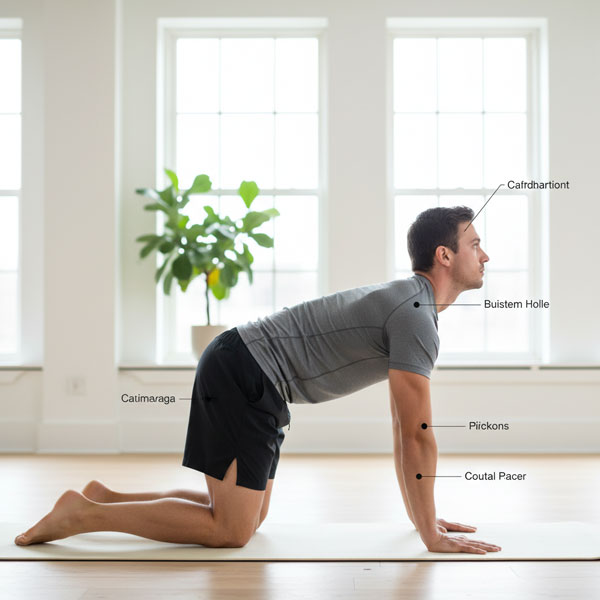
Knees and Hips
Knees and hips are critical weight‑bearing joints that require balanced strengthening and mobility training. Home based exercise therapy for this region aims to enhance stability, reduce pain, and restore functional movement. Canadian physiotherapists often prescribe low impact exercises like the clamshell and supported squat, which target glutes, quadriceps, and hip abductors. These drills improve alignment, making walking, climbing, and sitting easier. Proper technique ensures load is distributed safely, preventing cartilage wear or ligament strain. With consistency, such routines improve daily comfort and protect against reinjury. Simple equipment or body weight alone is enough to gain lasting benefits for overall joint health.
Clamshell Exercise
The clamshell exercise strengthens hip abductors and stabilises the pelvis, essential for knee health. Lying on your side with knees bent, lift the top knee while keeping feet together, then return slowly. Canadian physiotherapists value this drill for correcting inward knee collapse during walking or running. It helps relieve strain on knees, hips, and lower back by improving muscle balance. Resistance bands can raise intensity as strength builds. The clamshell is safe, accessible, and requires minimal space, making it ideal for home therapy. With consistent practice, it reinforces lower limb alignment, boosts hip stability, and supports injury prevention in daily activities.
Supported Squat
The supported squat is a modified version of the squat, allowing safe strengthening for knees and hips. Stand holding onto a stable surface, bend knees and hips slowly, then return to standing. This targets the quadriceps, glutes, and hamstrings without overloading the joints. Canadian physiotherapists use it to improve muscle endurance for daily tasks like rising from chairs or climbing stairs. Adjusting squat depth ensures comfort while still challenging muscles. By promoting joint stability and functional strength, the supported squat is a reliable choice for home based rehabilitation, especially for older adults or those recovering from lower limb injury or surgery.
Neck and Shoulders
Neck and shoulder issues often stem from posture errors, stress, or repetitive strain. Home based exercise therapy restores flexibility and strength while reducing pain. Canadian physiotherapists combine isometric stretches for the neck with shoulder‑stabilising drills to ensure balanced recovery. Targeted work on deep cervical muscles eases stiffness, while shoulder strengthening prevents impingement and aligns the upper body. Exercises like the static neck stretch and banded external rotations are safe, accessible, and effective. When practised consistently, they enhance posture, improve movement endurance, and make daily actions such as lifting, typing, or driving more comfortable, all without requiring specialised equipment or clinical visits.
Static Neck Stretch
The static neck stretch gently lengthens muscles along the side of the neck, easing tension and improving mobility. Sit or stand upright, tilt your head toward one shoulder, and hold for 20–30 seconds. Canadian physiotherapists advise slow, steady breathing during the stretch to enhance relaxation and avoid muscle guarding. This exercise helps reduce headaches, ease stiffness from desk work, and support healthy cervical posture. It is simple, equipment‑free, and suitable for all fitness levels. When incorporated into daily routines, the static neck stretch supports better range of motion, reduces discomfort, and complements both strength and rehabilitation programs for the neck.
Shoulder Strengthening
Shoulder strengthening exercises target the rotator cuff and scapular stabilisers, essential for joint stability and injury prevention. One effective home therapy drill is the standing external rotation using a resistance band. Keep elbows bent at 90 degrees and close to the body, rotate the arm outward, then return slowly. This builds balanced strength, improves posture, and enhances upper limb function. Canadian physiotherapists recommend it for recovery after strain or surgery, as well as for preventing overuse injuries common in desk or manual workers. Easy to adapt in intensity, this exercise supports lifting performance, reduces pain, and promotes long term shoulder health.
weekly home based exercise
A weekly home based exercise routine offers a structured way to improve strength, flexibility, and endurance without leaving your living space. Canadian physiotherapists emphasise the value of consistency, variety, and gradual progression to avoid overuse injuries. Such programs may include strength training, balance drills, mobility flows, and active recovery days. By planning sessions across the week, you can target different muscle groups while allowing adequate rest. This approach supports joint health, maintains cardiovascular fitness, and boosts daily energy. Tailoring the plan to your goals and physical needs ensures the safest, most effective path toward long‑term health and functional independence.

step by step weekly home based exercise therapy
Gentle Foundation (Days 1–2)
Begin with light mobility drills such as neck rolls, shoulder shrugs, and ankle circles.
Follow with gentle stretches for the back, hips, and calves.
Focus on slow breathing to relax muscles and prepare your body.
Stop any movement that causes sharp discomfort.
Core and Stability (Days 3–4)
Include cat cow for spinal mobility and glute bridges for hip strength.
Add forearm planks, holding for 15–30 seconds to engage core muscles.
Use a wall or chair for safe support during balance exercises.
Keep movements controlled and within a pain‑free range.
Strength and Endurance (Days 5–6)
Perform supported squats, clamshells, and resistance‑band rows.
Aim for 2–3 sets of 8–12 repetitions per exercise.
Rest for 30–60 seconds between sets to recover.
Maintain posture and avoid locking joints during lifts.
Active Recovery (Day 7)
Engage in low‑impact activity like a short walk or stationary cycling.
Incorporate gentle stretching for major muscle groups.
Use deep, slow breathing to promote relaxation and blood flow.
Review your progress and adjust next week’s plan as needed.
limitations for home based exercise therapy
| Condition | Reason for Restriction |
|---|---|
| Recent surgery | Risk of disrupting healing tissues |
| Acute joint inflammation | May worsen pain and damage |
| Uncontrolled hypertension | Elevated risk during exertion |
| Severe osteoporosis | Higher fracture susceptibility |
| Heart rhythm disorders | Potential cardiac strain |
| Acute infection or fever | Delays recovery and reduces endurance |
| Unhealed fractures | Risk of bone displacement |
Common Questions About Home Based Exercise Therapy
Can I combine home based exercise therapy with gym workouts?
Yes, you can, as long as exercises do not conflict with your rehabilitation goals. Alternate days or adjust intensity to avoid overtraining, and always follow your physiotherapist’s advice.
Is home based exercise therapy effective without equipment?
Absolutely. Many therapeutic exercises rely on body weight, resistance bands, or household items. Focus on proper form and gradual progression for best results.
How soon will I notice improvements?
Most people feel increased mobility or reduced discomfort within 2–4 weeks. Consistency, correct technique, and patience are key to lasting benefits.
